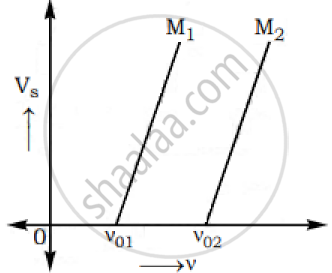Advertisements
Advertisements
Question
The threshold wavelength of silver is 3800Å. Calculate the maximum kinetic energy in eV of photoelectrons emitted, when ultraviolet light of wavelength 2600Å falls on it.
(Planck’s constant, h =6.63 x 1O-34J.s.,
Velocity of light in air, c = 3 x 108 m / s)
Solution
Wavelength of silver, λ1 = 3800 Aº
Wavelength of ultraviolet light, λ2 = 2600 Aº
H = 6.63 × 10-34 Js
Velocity of light in air, c = 3 × 108 m/s
To calculate kinetic energy, K.E. = hv − hvº
`"K.E."="hc"[1/lambda-1/lambda_o]`
`"K.E."=19.89xx10^-19[1/2.6-1/3.8]`
`"K.E."=(2.416xx10^-19)/(1.6xx10^-19)`
K.E. = 1.51 eV
Hence, the maximum kinetic energy emitted by the photoelectron is 1.51 eV.
APPEARS IN
RELATED QUESTIONS
The energy of photon of wavelength X is_____ .
[h = Planck’s constant, c = speed of light in vacuum]
Find the value of energy of electron in eV in the third Bohr orbit of hydrogen atom.
(Rydberg's constant (R) = 1· 097 x 107m - 1,Planck's constant (h) =6·63x10-34 J-s,Velocity of light in air (c) = 3 x 108m/ s.)
State two important properties of photon which are used to write Einstein’s photoelectric equation.
Define (i) stopping potential and (ii) threshold frequency, using Einstein’s equation and drawing necessary plot between relevant quantities.
Write Einstein's photoelectric equation and mention which important features in photoelectric effect can be explained with the help of this equation.
The maximum kinetic energy of the photoelectrons gets doubled when the wavelength of light incident on the surface changes from λ1 to λ2. Derive the expressions for the threshold wavelength λ0 and work function for the metal surface.
A proton and a deuteron are accelerated through the same accelerating potential. Which one of the two has less momentum?
Give reasons to justify your answer.
Write its S.I. unit of (intensity of radiation)
Radiation of frequency 1015 Hz is incident on two photosensitive surface P and Q. There is no photoemission from surface P. Photoemission occurs from surface Q but photoelectrons have zero kinetic energy. Explain these observations and find the value of work function for surface Q.
Einstein's photoelectric equation is:
a) `E_"max" = hlambda - varphi_0`
b) `E_"max"= (hc)/lambda varphi_0`
c) `E_"max" = hv + varphi_0`
d) `E_"max" = (hv)/lambda + varphi_0`
Write the basic features of photon picture of electromagnetic radiation on which Einstein’s photoelectric equation is based.
According to Einstein’s model, the threshold frequency for a metal having work function ϕ0 is given by _________.
Which of the following graphs correctly represents the variation of maximum kinetic energy (Ek) of photoelectrons with the frequency (𝜈) of the incident radiation?
Calculate the maximum kinetic energy of photoelectrons emitted by a metal (work function = 1.5 eV) when it is illuminated with light of wavelength 198 nm.
Plot a labelled graph of |Vs| where Vs is stopping potential versus frequency f of the incident radiation. State how will you use this graph to determine the value of Planck's constant?
In an inelastic collision, which of the following does not remain conserved?
Dimensions of ‘resistance’ are same as (where h is Planck's constant and e is charge):
Einstein work on the photoelectric effect provided support for the eqn:-
Who indirectly determined the mass of the electron by measuring the charge of the electrons?
If the frequency of light in a photoelectric experiment is double the stopping potential will
What is the momentum of photon of energy 3 mev in kg ms-1?
Which of the following is/are true for cathode ray
The emission of electron is possible
The wavelength of matter is independent of
How does stopping potential in photoelectric emission vary if the intensity of the incident radiation increases?
The graphs below show the variation of the stopping potential VS with the frequency (ν) of the incident radiations for two different photosensitive materials M1 and M2.

Express work function for M1 and M2 in terms of Planck’s constant(h) and Threshold frequency and charge of the electron (e).
If the values of stopping potential for M1 and M2 are V1 and V2 respectively then show that the slope of the lines equals to `(V_1-V_2)/(V_(01)-V_(02))` for a frequency,
ν > ν02 and also ν > ν01
